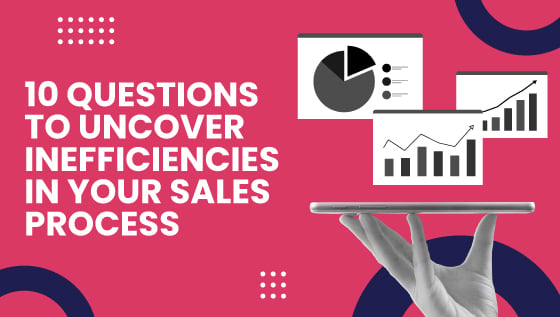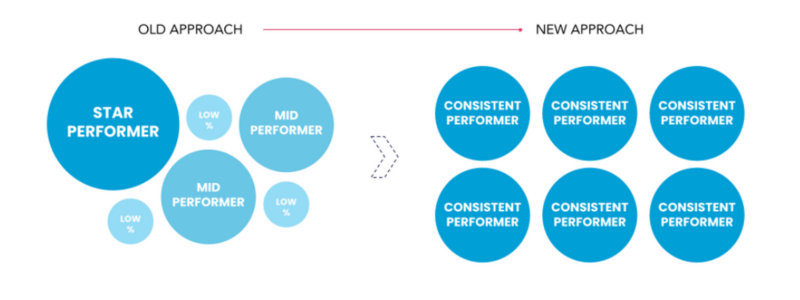


10 Questions To Uncover Inefficiencies in Your Sales Process




There's nothing quite like the thrill of hitting targets and sealing deals. The last two years have been a remarkable journey marked by exponential successes leading to bigger budgets, more hires, and an overarching central theme we like to call, “Growth At All Costs”.
Once sales leaders were able to reliably predict revenue, selling became a formula based on team productivity. Do more, sell more. But now, the macro-environment looks different: budgets are tighter, sales cycles have lengthened, and prospects are harder to reach.
The sales' playbook is now fractured.
This is where revenue operations (RevOps) comes into play - by fostering collaboration, data-driven decision-making, and streamlined processes, RevOps enables businesses to enhance the customer experience, drive revenue growth, and maintain a competitive edge in the market. Ensuring your revenue operations are efficient is critical for achieving your business objectives.
So, let's dive in and discover the various inefficiencies that may be affecting your revenue operations and hence, hindering your sales team's performance.
1. Are your forecasts accurate each month?
- Processes are not standardised
- Your team is not leveraging the right leading indicators to guide forecasting
- Sales and marketing teams are not aligned on goals or strategy
Companies can also make use of tools like HubSpot’s weighted pipeline forecast report and forecast tool to create a more nuanced view of the pipeline and predict sales revenue
2. Do you have both high-performing and low-performing sales reps?
Understanding the performance distribution within your sales team is imperative, because at the end of the day when you strip back all of the systems, the content, and the tech, sales and business boils down to relationships.
By distinguishing between high and low performers, you establish a benchmark for what is achievable within your sales team. This benchmark can guide expectations, goal setting, and performance standards. Relying solely on your top sales performers may yield short-term results, but it's not scalable. Failing to identify low-performing reps can lead to underperformance persisting and negatively impacting sales.
It's crucial to implement a comprehensive solution plan, that promotes consistent team performance, optimize processes, and create a more efficient and effective sales team. An ideal plan would include the following steps:
- Allocate resources effectively based on who requires more support & training.
- Skill development and customised coaching to help team members reach their full potential.
- Optimising the process by analysing how high performers do things differently.
- Set goals & establish accountability to take ownership of tasks and improve.

3. Do your sales reps use 1+ tools for prospecting, contact, and deal management, forecasting, and sending quotes?
Take a quick look at your tech stack, and analyse how many tools you use through various stages of your sales cycles. If you're using multiple tools then it's probably not an efficient way to work, and here are a few reasons why:
- Increased complexity - With different tools on your tech stack your sales team has to get trained and master every single one of them, making it more challenging than it needs to be.
- Data fragmentation - Scattered information across different tools can make it difficult to stay up-to-date with the records, making it difficult to analyse reports and trends. This breeds room for errors, miscommunication, and data inconsistencies.
- Disrupt workflow - Switching between various sales tools can affect your team's productivity as they may spend more time navigating between applications than focusing on revenue-generating activities.
- Inconsistent customer experience - Different tools can lead to inconsistencies in how customers are
approached and managed. Your salesmen may forget to log interactions or follow up, leading to a less than ideal customer experience. - Communication gaps - Using multiple tools can result in communication gaps within the team. Team members may not have access to the same information, making it difficult to collaborate effectively or hand off leads and deals smoothly.
While there may be situations where using multiple tools is necessary due to unique business needs, the rule of thumb in RevOps states that it's more efficient and effective to streamline your sales processes using consolidate, integrated platform. This minimises complexity, enhances productivity, and ensures a more consistent and data-driven approach to sales operations
4. Is your marketing to sales handover process automated?
Your marketing and sales teams must work hand in hand to convert leads into customers successfully. If your marketing to sales handover process is manual and disjointed presents several challenges. These include delayed lead follow-up, increased risk of lost or mishandled leads, poor lead qualification, ineffective tracking and reporting, inefficient communication, and higher labor costs.
These inefficiencies can lead to lost opportunities, data discrepancies, and difficulties in analysing marketing and sales performance accurately.
Investing in a Customer Relationship Management (CRM) system like HubSpot that integrates marketing and sales functions can help ensure that your team is capable of lead tracking, scoring, and automated handovers.
This approach enhances collaboration between the two teams and contributes to better conversion rates and revenue generation.
5. Do your sales leaders have a centralised dashboard to monitor performance?
The absence of a centralised dashboard for monitoring a sales team's performance can have several adverse effects. It results in data fragmentation, making it challenging to obtain a comprehensive view of the team's performance. Collecting data from various sources becomes time-consuming and inefficient, leading to inconsistencies in the data and delayed reporting. The complex analysis of performance data is hindered, impacting the ability to identify trends and correlations. Transparency and accountability suffer, and setting performance goals is less effective without clear visibility into past and current performance. Benchmarking against industry standards is also compromised. Scaling and adapting to changes become more challenging.
To address these challenges, organisations should invest in a CRM that integrates data from various sources, providing a unified view of sales performance. A centralised dashboard streamlines data collection, ensures consistency, allows for real-time monitoring, and enables data-driven decision-making, all of which contribute to more effective and efficient sales team management.
.png?width=800&height=686&name=North%20Star%20Dashboards%20(small).png)
6. Can your sales teams easily see which deals to prioritise?
Your sales reps need to prioritise their leads and deals based on their likelihood of closing. Without a clear system for prioritisation, sales teams may overlook valuable opportunities. They might spend time on less promising leads while neglecting more high-potential prospects, resulting in lost revenue among other issues:
- Poor customer experience resulting from neglecting lead prioritisation that can lead to delays in response times and ineffective customer engagement.
- Disorganized workflows within the team and lack of alignment in sales efforts
- Increased opportunity cost for the organization
- Ineffective time management and reduced efficiency
Sales leaders should work on defining clear prioritisation criteria, such as deal size, lead source, and engagement level, and then implementing a scoring system to objectively rank and prioritise deals based on these criteria.
The use of a CRM system, integrated with lead generation tools, automates the scoring process and ensures real-time data updates. Training the sales team on the criteria and fostering open communication is crucial for alignment. Regular data reviews and adjustments to criteria, coupled with managerial oversight, guarantee the ongoing effectiveness of the system.
7. Have you identified/documented the data points you want to measure in your sales processes?
From demand generation through to customer success you need to understand what metrics impact your business. To improve the efficiency of your sales process, you need to identify and document the key data points that you want to measure.
Not doing so can hinder clarity, consistency, and efficiency in sales operations. It can lead to a lack of uniformity in tracking, goal setting, and performance evaluation, making it challenging to drive meaningful improvements and growth within the sales team.
Identifying and documenting key data points is fundamental to a data-driven, efficient sales strategy.
8. Do you use automation to support your data collection process across the buyer's journey?
Automating data collection across the buyer's journey in a sales process brings numerous advantages.
It enables real-time data capture at various customer touch points, ensuring data accuracy and consistency. Centralised in a CRM system, this data provides a comprehensive view of prospects and customers, allowing for personalised communication and efficient lead nurturing.
Automation also includes lead scoring, prioritising opportunities, and reducing manual data entry for sales teams. Predictive analytics can leverage this data to anticipate customer needs and inform sales strategies.
Automated performance monitoring, reporting, and workflow automation enhance sales efficiency.
By streamlining data collection, automation empowers sales teams to focus on strategic activities, improving customer engagement, revenue growth, and satisfaction.
9. Do you have a shared definition of a good lead?
Take a moment to understand whether your team is aligned on what is your agreed definition a good lead.
The absence of a shared definition of a good lead amongst your team members can lead to inefficiencies, reduced conversion rates, inconsistent lead qualification, and strained interdepartmental relationships.
To avoid these challenges, it's essential for sales and marketing teams to establish and maintain a clear and shared understanding of what constitutes a good lead.
- This improves time management and resource allocation, increasing overall efficiency.
- It ensures that all team members use the same criteria to evaluate leads, reducing subjective judgments and potential biases.
- Teams can use data to adjust their lead generation and nurturing strategies based on the performance of leads that meet the established criteria.
- With a shared definition, it is easier to predict and forecast sales outcomes accurately. This helps in setting realistic goals and budgets.
10. Does your Sales Team reference your ICP & Persona?
ICP and Personas provide a clear picture of your ideal customers, including their needs, pain points, and characteristics. This makes it a lot easier for sales teams to centre conversations and show the value effectively, making it hard for prospects to picture life without your product or service.
Focusing on your ICP & Persona can substantially improve your team's performance in a number of ways:
- You can tailor their outreach and messaging to address these specific attributes, increasing the relevance of their communication.
- This targeted approach leads to higher conversion rates and a more efficient sales process.
- Reduce wasted efforts and resources spent on unlikely prospects, optimizing their productivity.
- Knowing the persona and needs of an existing customer allows you to identify cross-selling and up-selling opportunities, increasing customer lifetime value
- You can analyse the performance of different personas and adjust their strategies based on real-world insights.
Efficient revenue operations are the driving force behind a successful business. By regularly asking these 10 essential questions and implementing improvements where needed, your revenue operations can achieve peak efficiency, drive revenue growth, and stay ahead in a competitive market. Constantly seeking ways to enhance your revenue operations is key to long-term success and sustainable growth.








